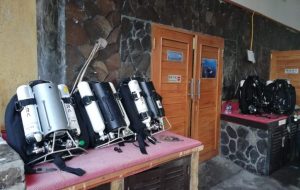Tech Diving Safety
There is an argument to be made that tech diving is safer than it was 30 years ago. Deep diving on air is now considered taboo, and rebreather diving allows helium to be used without worrying about the cost. The sophistication, functionality, and reliability of dive computers have hugely increased, and our understanding of decompression theory has steered us away from previously established practices such as deep stops.
Diving physiology has also evolved. We have a better understanding of decompression stress, and know more about Immersion Pulmonary Edema (IPE) than when it was first described in 1989 (It’s called Oedema in the UK and abbreviated to IPO). Consequently, such knowledge helps divers to plan dives more effectively and manage the risks associated with deep and extended dives.
Dive Equipment Improvements
Since the 1990s, improvements in the design of dive equipment has played a crucial role in the development of tech diving. Modern dive computers offer detailed tracking and real-time decompression data, significantly aiding tech divers to manage their safety. Dive equipment is very well made. It’s stronger, more reliable, and often tailored for specific uses, e.g. sidemount harnesses.
Popularity of Rebreather Diving
As tech diving has grown in popularity, so has rebreather diving. There are multiple reasons for this. With skyrocketing helium prices, more open circuit tech divers have begun CCR diving to undertake deeper dives without going bankrupt. Undoubtedly, this should be balanced against the cost of buying a rebreather and getting trained on it.
In the last 20 years, significant improvements in rebreather build quality and reliability have increased their safety. Unquestionably, the human element is still the largest contributor to CCR incidents and fatalities, but equipment malfunctions are much rarer as long as the manufacturer’s recommendations for maintenance are carried out.
Opening up new types of diving
There’s a reason that the course you take when learning how to dive is called the open water course. Open water means that you always have direct access to the surface. Recreational divers should never enter an overhead environment such as a wreck or cave without the correct training and equipment. Similarly, recreational divers should never dive deeper than 40m (130ft).
Tech diving exists specifically to allow divers to dive deeper, and enter overhead environments such as wrecks and caves. It’s not a case of simply using additional equipment and carrying extra gas. Rather, it requires incremental training to understand and utilise appropriate equipment and dive procedures. Technical dive training opens up a lot of diving locations that are off-limits to recreational divers, such as many of the wrecks in Chuuk Lagoon.
Technical diver training
For recreational divers looking to explore tech diving, Intro to Tech and Sidemount courses are a great start for learning the fundamentals. Both courses introduce the equipment and principles unique to technical diving. Divers should gain experience before progressing to more advanced training such as decompression procedures and trimix diving. Rebreathers have a separate training path, and I highly recommend that divers gain experience in open-circuit decompression diving before progressing to rebreather diving.
With ongoing improvements in technology, equipment, and training, tech diving has become more accessible and is taught in more dive centres than ever. If you enjoy being challenged and love to learn new things, tech diving might be exactly what you’re looking for.
Look around this website to learn more about all aspects of technical diving. I hope you enjoy the content.














